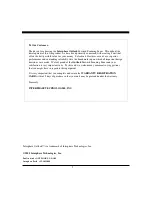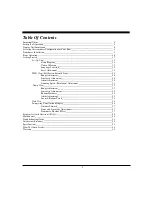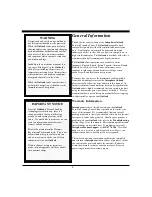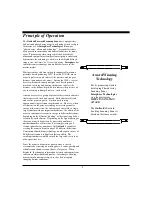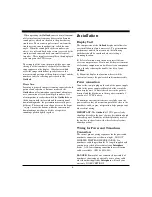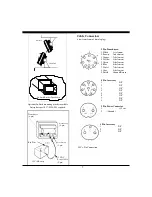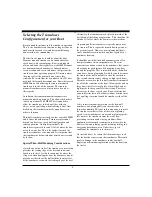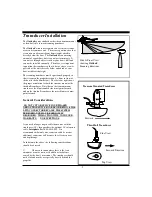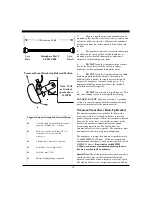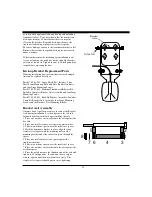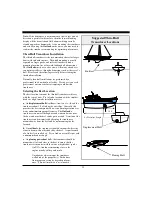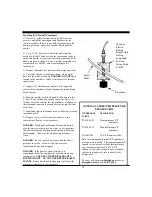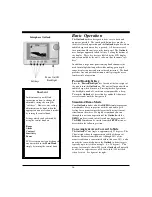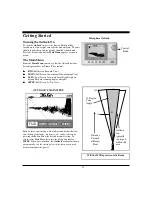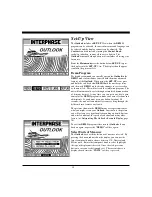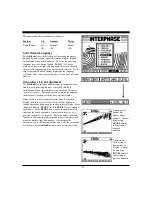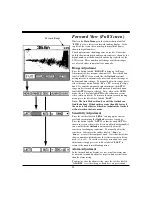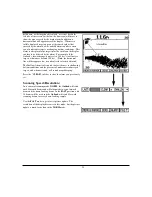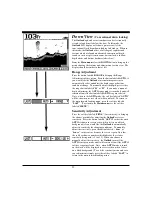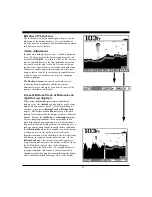
8
Selecting the Transducer
Configuration for your Boat
Keep in mind the primary rule for transducer operation.
This is: the transducer can function as long as it has an
unobstructed forward view and has smooth flowing
non-aerated water surrounding it.
The first line of inquiry should be about the boat.
Transom mounted transducers are intended for low
speed boats with external props. Boats with inboard
motors and boats that regularly exceed 40MPH cannot
use transom mounted transducers. Inboard motors
create aeration and excess turbulence that prevent the
transducers from operating properly. I/O motors where
the prop is aft of the transom do not create this
situation. Be careful that the driveshaft of the I/O does
not block the forward horizontal scan. Boats that exceed
40MPH run a risk of having the transom mounted
transduers torn free of the transom. The transom
mounted transducers are not designed to be used at
these speeds.
In addition, the transom mounted transducers are
mounted on kick-up brackets. This allows the brackets
to kick up at about 35-40MPH. This is intended to
allow the transducers to kick-up if they strike an
object, or to be pulled up when trailering a boat. Once
kicked up, the transducers must be manully reset in
order to function.
Thru-hull transducers are for boats that exceed 40MPH
and /or have inboard motors. Transducer placement
depends on boat size, speed, hull configuration and
sonar application. On displacement hulls, the
transducer is generally located 1/3 aft of where the bow
meets the water line. This is the farthest forward the
transducer should ever be mounted. It is important that
the transducer be below turbulent aerated water created
by the bow.
Special Thru-Hull Mounting Considerations
On sailboats with a fin keel, the transducer is most often
placed at the leading edge of the keel and sometimes
faired into the keel. As this location may be where the
sling rests when hauling the boat, the transducer may be
placed on either side of the hull with the foremost face
of the transducer even with the leading edge of the keel.
Alternatley, the transducer may be placed forward of the
keel ahead of the lifting strap location. This should not be
ahead of 1/3 aft of where the bow meets the waterline.
On planing hulls the transducer is typically placed near
the transom. This is to provide smooth flowing water at
the greastest speed. However, most planing hull boats
create transducer aeration when on plane regardless of
transducer location.
It should be noted that thru-hull transducers can effect
boat performance in two important ways. The first
concern is cavitation created by the transducer that causes
reduced engine performance by disrupting water flow
around the propeller. This is smoothed out by the hull in
some boats, but on planing hulls with the transducer near
the transom, the hull is not able to clear the cavitation.
The second concern is uneven drag on high-speed boats.
This may occur when the thru-hull transducer is mounted
far off of the centerline of the boat. At low speeds and on
large boats the effect is negligible. On smaller boats at
high speeds the drag can effect the steering. The effect
increases as the boat’s speed rises. Boats with trim tabs
can usually trim this out, but boats without trim tabs may
feel a pulling sensation toward the transducer side of the
boat.
A less intuative mounting location for the thru-hull
transducer on a planing hull is on the centerline just
forward of midship. The goal in this mounting is to place
the transducer so that it is out of the water at planing
speed. As most transducers are aerated at planing speeds,
this removes the transducer from the water flow
preventing cavitation and steering problems. Most
applications for forward scanning sonar occur when the
boat is at low non-planing speeds, including fishing and
navigating hazardous waters. Under these speed
conditions the transducer is in the water.
On trailered boats, be certain that the mounting is such
that the boat does not rest on the transducers. This could
result in damage to the transducer and/or boat hull.
Explore possible mounting locations while the boat is on
the trailer.
Summary of Contents for Outlook
Page 1: ...1 OPERATION MANUAL...
Page 36: ...36...


